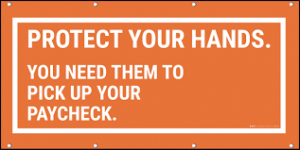Protecting your fingers and hands is important for your work and quality of life. Work-related hand injuries are one of the leading reasons workers end up in the emergency room and miss work. Damage to the nerves in your fingers and hands, loss of a finger, a skin burn or allergic reaction, can negatively impact the quality of your work, your productivity – or worse – end your career and seriously detract from your quality of life. The cost of these types of injuries and illnesses to the construction industry is estimated in the hundreds of millions of dollars each year.
Causes of hand injuries
How many times have you grabbed a sharp object, touched a hot surface, felt pain in your hand because of how you were gripping a tool or twisting your wrist, come close to getting your hand or finger caught or crushed, or had your skin come in contact with a chemical or caustic material? If you can think of even one time for any of these, it is one time too many. There are many hazards on construction sites that can result in a hand injury, including:
- Punctures, cuts or lacerations – caused by contact with sharp, spiked or jagged edges on equipment, tools or materials.
- Crushed, fractures or amputations – caused by contact with gears, belts, wheels and rollers, falling objects, and rings, gloves or clothing getting caught and putting your hand in harm’s way.
- Strains, sprains, and other musculoskeletal injuries – caused by using the wrong tool for the job, or one that is too big, small or heavy for your hand.
- Burns – caused by direct contact with a hot surface or a chemical.
- Dermatitis and other skin disorders – caused by direct contact with chemicals in products and materials.
Preventive measures
Follow the work practices and use the equipment and gloves provided by your employer. Gloves and safety procedures won’t work if they’re not used or followed. Be aware of the job tasks, equipment and materials that can create a risk for a hand injury or put your skin in contact with a chemical, and know the steps that should be taken to prevent exposures and injuries.
Specific –
- Always stay alert and focused on keeping your hands safe – not just at the start of work or a task.
- Keep guards on machinery and power tools in place – Don’t remove or reposition them.
- Use tools and equipment designed for the work being performed and use them as instructed by your supervisor and/or the manufacturer.
- Don’t put your hands or fingers near the moving parts of a power tool or equipment. Make sure machinery, equipment and power tools are completely off before you try replacing, cleaning or repairing parts – follow lock-out/ tag-out procedures.
- Identify safety features on tools and equipment before you use them, such as emergency off switches.
- Check tools and equipment to make sure they are in proper working order before beginning a task.
- Keep hands and fingers away from sharp edges (blades, protruding nails, etc.). Never cut toward the palm of your hand.
- Select hand tools that are ergonomic for your hand (the right size, lowest weight, and have features such as grips, anti-vibration handles, handles angles that allow you to work without your wrist bent.)
- Wear gloves that fit your hand and are right for the work being performed – not all gloves protect against all hazards.
- Do not wear rings, other jewelry or lose articles of clothing that could get caught on a moving object.
Shop online for good quality and affordable Hand Glooves at Jashsupplies.com












 WhatsApp us
WhatsApp us